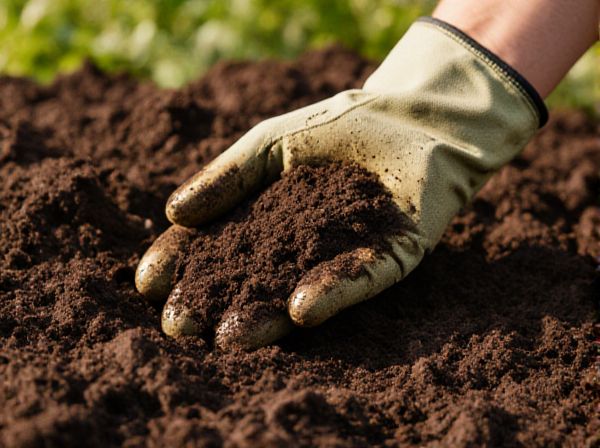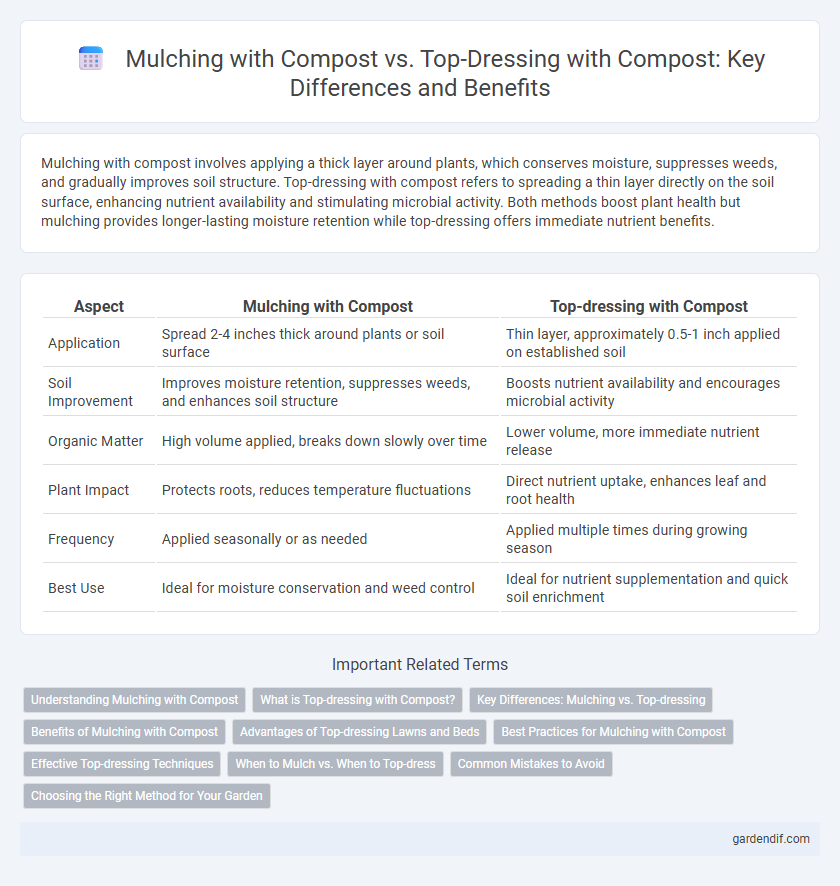
Mulching with Compost vs Top-dressing with Compost Illustration
Mulching with compost involves applying a thick layer around plants, which conserves moisture, suppresses weeds, and gradually improves soil structure. Top-dressing with compost refers to spreading a thin layer directly on the soil surface, enhancing nutrient availability and stimulating microbial activity. Both methods boost plant health but mulching provides longer-lasting moisture retention while top-dressing offers immediate nutrient benefits.
Table of Comparison
| Aspect | Mulching with Compost | Top-dressing with Compost |
|---|---|---|
| Application | Spread 2-4 inches thick around plants or soil surface | Thin layer, approximately 0.5-1 inch applied on established soil |
| Soil Improvement | Improves moisture retention, suppresses weeds, and enhances soil structure | Boosts nutrient availability and encourages microbial activity |
| Organic Matter | High volume applied, breaks down slowly over time | Lower volume, more immediate nutrient release |
| Plant Impact | Protects roots, reduces temperature fluctuations | Direct nutrient uptake, enhances leaf and root health |
| Frequency | Applied seasonally or as needed | Applied multiple times during growing season |
| Best Use | Ideal for moisture conservation and weed control | Ideal for nutrient supplementation and quick soil enrichment |
Understanding Mulching with Compost
Mulching with compost involves spreading a thick layer, usually 2 to 4 inches, of organic material directly on the soil surface to conserve moisture, regulate soil temperature, and suppress weed growth. This practice enhances soil structure by gradually decomposing and enriching the soil with nutrients, promoting microbial activity essential for plant health. Regular mulching with compost improves water retention and reduces erosion, making it a sustainable soil management technique in gardening and agriculture.
What is Top-dressing with Compost?
Top-dressing with compost involves spreading a thin layer of compost directly onto the soil surface or around plants without disturbing the soil underneath. This method enhances soil fertility, improves moisture retention, and gradually supplies nutrients to plants as the compost breaks down. Unlike mulching, which primarily protects soil and suppresses weeds, top-dressing focuses on nutrient enrichment and soil structure improvement.
Key Differences: Mulching vs. Top-dressing
Mulching with compost involves applying a thick layer on the soil surface to retain moisture, regulate temperature, and suppress weeds, while top-dressing with compost consists of spreading a thinner layer to gradually improve soil fertility and structure. Mulching creates a protective barrier that breaks down slowly, contributing to long-term soil health, whereas top-dressing delivers nutrients more directly to plant roots for quicker absorption. Both methods enhance soil quality but differ in application thickness, function, and the rate at which compost nutrients become available.
Benefits of Mulching with Compost
Mulching with compost improves soil moisture retention by reducing evaporation and insulating soil against temperature fluctuations, promoting healthier root development. The decomposition of compost mulch gradually releases essential nutrients, enhancing soil fertility and microbial activity more effectively than top-dressing. This method also suppresses weed growth, reducing competition for resources and supporting stronger plant growth.
Advantages of Top-dressing Lawns and Beds
Top-dressing lawns and beds with compost enhances soil structure and promotes nutrient retention more effectively than mulching, leading to improved root growth and healthier plant development. It provides a thin, even layer of organic matter that gradually integrates into the soil, enriching microbial activity without suffocating plants. This method also reduces soil erosion and inhibits weed growth while maintaining optimal moisture levels for sustained plant vitality.
Best Practices for Mulching with Compost
Mulching with compost enhances soil moisture retention, suppresses weeds, and improves soil structure by maintaining a consistent organic layer around plants. Applying a 2-4 inch thick layer of compost as mulch prevents nutrient leaching and regulates soil temperature while gradually enriching the soil with essential microbes. Best practices include using well-matured compost, avoiding direct contact with plant stems to prevent rot, and refreshing the mulch annually to sustain soil health and plant growth.
Effective Top-dressing Techniques
Top-dressing with compost enhances soil nutrient availability by evenly spreading a thin layer of mature compost on the soil surface, promoting microbial activity and moisture retention without disturbing plant roots. Effective top-dressing techniques include applying 0.5 to 1 inch of compost annually or semi-annually, avoiding compost with high nitrogen content to prevent root burn, and incorporating compost near the drip line for optimal nutrient absorption. This method sustains long-term soil health and supports plant growth better than mulching with compost, which primarily serves as a moisture barrier.
When to Mulch vs. When to Top-dress
Mulching with compost is ideal during early spring or after planting to conserve moisture, regulate soil temperature, and suppress weeds, creating a protective barrier that enhances root growth. Top-dressing with compost is best applied during the growing season or fall to gradually enrich the soil with nutrients without disturbing plant roots, supporting healthy plant development and improving soil structure over time. Understanding the plant's growth stage and soil needs helps determine whether mulching or top-dressing optimizes compost benefits for garden health.
Common Mistakes to Avoid
Mulching with compost often suffers from the mistake of applying too thick a layer, which can smother plants and prevent proper air and water penetration, typically exceeding the recommended 2-3 inches. In top-dressing, a common error is uneven application, which leads to inconsistent nutrient distribution and patchy soil health improvement. Both methods require proper timing and moisture management to avoid nutrient runoff and compost degradation.
Choosing the Right Method for Your Garden
Mulching with compost involves applying a thick layer around plants to retain moisture, suppress weeds, and improve soil structure, making it ideal for new or heavily amended gardens. Top-dressing with compost consists of spreading a thinner layer on the soil surface to gradually enhance nutrient levels and soil microbial activity without disturbing established plants. Selecting the appropriate method depends on garden goals: mulch for moisture control and weed prevention, top-dressing for ongoing soil enrichment and gentle nutrient addition.
Mulching with Compost vs Top-dressing with Compost Infographic

 gardendif.com
gardendif.com